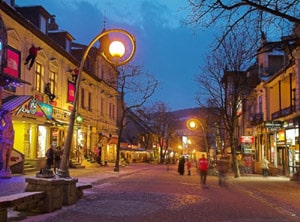
A few years ago, Zakopane’s mayor (burmistrz) Janusz Majcher spoke to a large crowd assembled in the City Hall about the future of his city. But he first decided to comment on its past in order to understand its present and project its future. Today, Zakopane next to Warsaw and Krakow, is the most popular tourist attraction in Poland. Yet, the mayor pointed out, Zakopane did not become a city until 1933. Earlier, for more than a hundred years it was simply a mountain village that became phenomenally popular with Polish cultural elites that included Sienkiewicz, Witkiewicz, Zeromski, Paderewski, etc. Seduced by the rich and unique folk culture of the górale (highlanders) and the natural breathtaking beauty of the surrounding Tatra Mountains, they spent their summer vacations in this mountain village situated at the base of Mount Giewont. When Poland regained her independence in 1918 Zakopane eventually became a favorite spot for Polish society in general both for summer and winter vacations. Mayor Majcher said that he understood what made Zakopane wonderfully attractive to so many people, and therefore, declared that he wanted to preserve the atmosphere of this unique „large village” (wiejskosć i swojskosć) with its traditional regional architecture and its beautiful natural environment. He emphasized the importance of clean air and the use of geothermal energy.

In recent year, many Polish American tourists have expressed their disillusionment with Zakopane. Writing in „Am-Pol Eagle”, Ed Wiater wrote, „On my umpteenth visit to Zakopane last year, I was jolted by what I saw on Krupowki Street. This main tourist avenue has taken on a honky-tonk garb. The street reminded me of Clifton Hill in Niagara Falls, Ontario: one shop after another with the same tourist junk (made in China).” I am forced to agree with this observation since it supports what I had seen just two years ago. It was a shock to see this cheap, honky-tonk scene, which I considered a blasphemy and profanity to the traditional local folk culture.
More important may be the testimony of professionals like Art Historian, Dr. Barbara Tondos, whose article „Marnowana Siawa” (Wasted Glory) is being featured in this issue of „The Tatra Eagle”. She has expressed outrage about the current construction practices in Zakopane, which reject and/or ignore the traditional architecture based on goral folk culture. The structure of Zakopane that has made it notable has been destroyed in the past twenty years, according to this scholar. „It is a process which seems to be irreversible” according to her. „By doing so, Zakopane is losing its charm and its individuality.” Some have enriched themselves building thoughtlessly large restaurants and resort hotels but Polish society has lost is cultural jewels (klejnoty). The unfortunate consequence is that today many Poles and foreigners are disenchanted with Zakopane. They find Zakopane less attractive and are choosing other mountain resorts in Slovakia, Italy, Austria which are less expensive, less crowded and more comfortable.
Most would agree that the construction of new buildings in Zakopane must meet current needs and conditions and require new solutions. But this should not require the abandonment and loss of traditional values that made Zakopane so fascinating and alluring in the past. A brutal rejection of local ties and traditions is no answer to Zakopane’s future. This is a conclusion that is held not only by Polish artists and architects but also by many others in the European Union. Mayor Majcher and his City Council would do well to ponder the views of persons like Dr. Tondos as well as the views of ordinary Polish American tourists who do not want to be disappointed when they make their next visits to Zakopane. They must find a creative way to achieve modernity without sacrificing the charm and traditional character of Zakopane.

Reprinted from THE TATRA EAGLE Vol.64, No2, 2011
THE TATRA EAGLE Issued by the Tatra Publishing Fund Co-Editors Janina Gromada Kedron Dr. Thaddeus V. Gromada Technical Editor: Henry P. Kedron Computer Consultants: Mariusz Bargielski, Joseph Gromada Contributing Editors: Maria Pudzisz, Krakow, Dr. Anna Gqsienica-Byrcyn, Chicago
Address all correspondence to: J. Kedron 31 Madison Ave., Hasbrouck Hts., NJ 07604
Email: ikedron@email.com Teromada@,mindsvrine.com
Annual subscription rate: $20 in USA $25 outside of US
